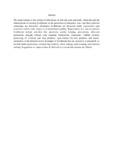| dc.description.abstract | The improvement of the welfare of inhabitants of arid and semi-arid lands, either through the enhancement of existing livelihoods or the promotion of alternative ones, and their potential constraints are discussed. Alternative livelihoods are discussed under regenerative and extractive themes with respect to environmental stability. Regenerative (i.e., non-extractive) livelihoods include activities like apiculture, poultry keeping, pisciculture, silkworm production, drought tolerant cash cropping, horticulture, community wildlife tourism, processing of livestock and crop products, agro-forestry for tree products, and microenterprises in the informal sector. Examples of livelihoods that are extractive or potentially so include timber production, woodcarving, basketry, brick making, sand scooping, and charcoal making. Suggestions to improve these livelihoods in a sustainable manner are offered. | en_US |

